#Japanese scripts
Explore tagged Tumblr posts
Text
From Hiragana to Kanji: Understanding the Three Japanese Scripts
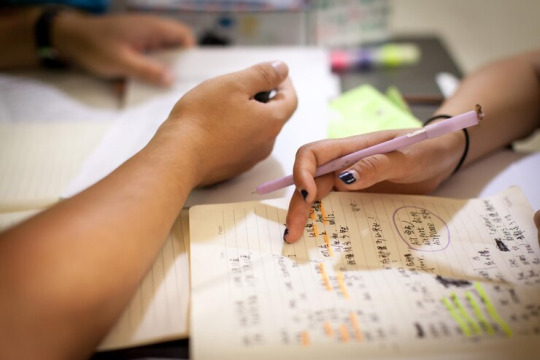
The beauty of the Japanese language lies not only in its sound but also in its writing system. If you’re just beginning your learning journey, you’ll quickly encounter one of the most unique aspects of the language—its use of three distinct Japanese scripts: Hiragana, Katakana, and Kanji. Understanding how these scripts work together is essential for reading, writing, and eventually speaking like a native.
1. Hiragana – The First Step
Hiragana is the most basic of the Japanese scripts and is usually the first one learners master. It consists of 46 characters, each representing a specific sound. Native Japanese words, particles, and grammatical endings are written in Hiragana. For example, “たべる” (taberu – to eat) and “わたし” (watashi – I) are written entirely in Hiragana. This script is essential for constructing basic sentences and learning verb conjugations.
2. Katakana – The Script of Foreign Words
Katakana is the second phonetic script in Japanese, also with 46 characters. It’s primarily used for writing foreign words, names, scientific terms, and emphasis. You’ll see it often in menus, advertisements, and pop culture. Words like “コーヒー” (koohii – coffee) and “ホテル” (hoteru – hotel) are written in Katakana. The characters are sharper and more angular than Hiragana, giving them a distinct appearance.
3. Kanji – The Ideographic Script
Kanji is the most complex part of the Japanese writing system. These characters were borrowed from Chinese and are used to represent entire words or ideas. Kanji are not phonetic—each character can have multiple readings depending on its context. For instance, the character “日” can be read as hi, bi, or nichi depending on usage. While there are thousands of Kanji, roughly 2,000 are commonly used in everyday Japanese. Learning Kanji adds depth and clarity to written text.
How to Learn the Japanese Scripts Effectively
At Japanese Language Classes, we help students master all three scripts through structured lessons, visual aids, interactive writing practice, and real-world reading material. We believe that learning Japanese scripts isn’t just about memorization—it’s about understanding the logic, beauty, and function behind them.
Whether you're aiming to pass the JLPT or simply want to read a Japanese novel, mastering the scripts is your first milestone. With the right support from Japanese Language Classes, you can read and write with confidence in no time.
#Japanese scripts#Hiragana#Katakana#Kanji#Japanese writing system#learn Japanese scripts#Japanese alphabet#Japanese for beginners#Japanese Language Classes#how to read Japanese#Japanese script guide#writing in Japanese#Japanese characters#study Japanese writing#JLPT preparation
0 notes
Text
I need your help with a hypothesis!
For context: My linguistics professor and I got into a discussion after a test she did with us, and I was of the opinion that the reason for the results was different from the one she offered, so she encouraged me to test my theory.
What I need
All you need to do is draw a coffee cup (with a handle, not the disposable stuff) and then answer three questions.
I don't need to see the coffee cup. You can draw it wherever you like; on a piece of paper, digitally, in the sand, on a foggy window. Anything works. It does not have to be good. A doodle is fine.
You have to draw the coffee cup before you see the questions. This is very important. If you decide to help me with this, please doodle the coffee cup before you keep reading.
Assuming you have drawn the coffee cup, I now need you to answer these three questions:
On which side did you draw the handle?
Are you right-handed or left-handed?
Do you primarily write using the Latin alphabet or a different one? (please specify which)
More context
Most people will draw the handle on the right side. My professor says it's because most people are right-handed, so they draw the handle in the direction that would be comfortable for them to pick up.
I said drawing it on the right side just felt more comfortable to my hand and argued it's probably because we write a bunch of letters like that. B, b, D, P, p, R all look like a tiny "handle on the right side" and are all a straight line followed by a round one (so "cup first, handle second," like most people draw cups). The Latin alphabet doesn't have letters like that that face the other way, except maybe d, depending on how you write it, so it makes sense to me that people writing mostly Latin letters would go with the handle on the right side.
Which means that I need to know what Asians, Arabs and Greeks do and if the distribution of left and right sides of handles differs from the Latin alphabet group. Cyrillic seems to favor right, too, though it'd be interesting to see if there are differences.
If there are, my theory is right. Doubly so if there is a sizeable increase in a group whose alphabet has letters that benefit the left side choice.
So feel free to spread this to as many people as you like and put the answers in the comments or the tags of a reblog. The more answers I get, the better I can assess whose theory is better.
Thank you for your help!
#language#linguistics#latin#greek#cyrillic#arabic#hebrew#chinese#japanese#korean#thai#sanskrit#there are way too many languages and scripts to add#but I hope these help out most folks with the tags at least#right-handed#left-handed#right side#left side#oh disposable coffee cups#the bane of my hypothesis#it needs to be a cup with a handle please#sorry for the confusion
9K notes
·
View notes
Text
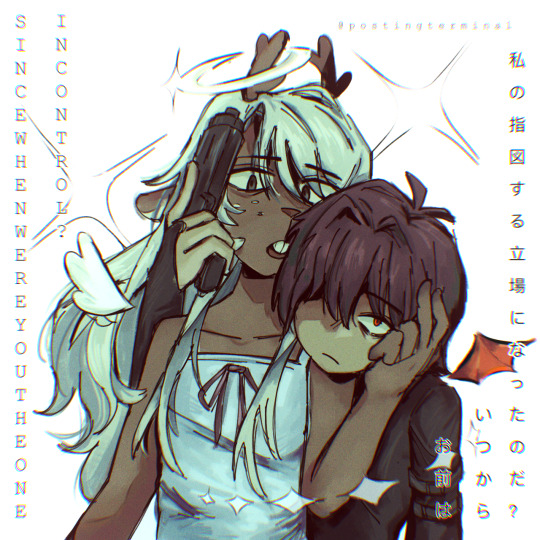
MY LIFE FORCE DRAINED — DEAR GOD, PLACE A CURSE ON THOSE WHO’VE WRONGED ME
#deltarune#kriselle#kris dreemurr#kris deltarune#noelle holiday#noelle deltarune#my art#the lyric in the caption is from angels in camp by jane remover#listened to it on loop while making it#also stream unmusique by lucy bedroque#idk i just really like drawing guns and cool shit this one is self indulgent as fuck#my cousin helped with the japanese writing btw#it took a weirdly long time because i couldnt find a jp undertale script text dump#so i had to go off a screenshot from reddit#bro#anyways
819 notes
·
View notes
Text




in the original script for Sonic Forces Silver was gonna call out Infinite on his B. S. and sass Knuckles over Operation Big Wave. we were robbed of some snappy Silver attitude

#sonic the hedgehog#silver the hedgehog#knuckles the echidna#infinite the jackal#vector the crocodile#sonic forces#he really said infinite was full of shit#and silver canonically really likes knuckles after this game too#just another way he be acting like rouge#silver and knuckles were work husbands#both the older script and the japanese forces scripts have some real gems#we were robbed#some changes make sense though because silver is taking the situation seriously
345 notes
·
View notes
Text

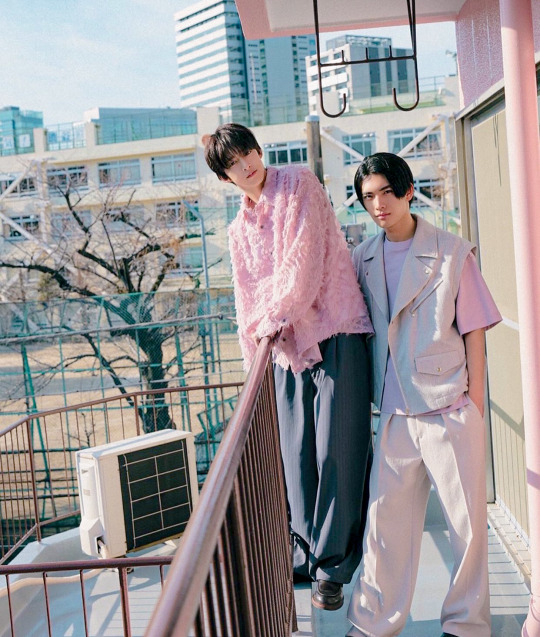
Asahi Ito & Moto Jun for AR MAGAZINE
#asahi ito#moto jun#when it rains it pours#futtara doshaburi#japanese actors#their show was good#but it could've been better with two more episodes and one script revision
84 notes
·
View notes
Text

A split-screen moment at a green tea shop! It's so cool to see the contrast of seal script and modern script!
茶 means tea, and it's read チャ or サ. For more vocabulary and how tea is talked about in Japanese, see here, and for a cool tea superstition, see here.
I love the spear-like appearance of the top radical here. It's 艹 grass crown, which can be easy to confuse with ⺮ bamboo crown in modern script. For example, 苗 seedling vs. 笛 flute. How easy is it to differentiate in seal script?

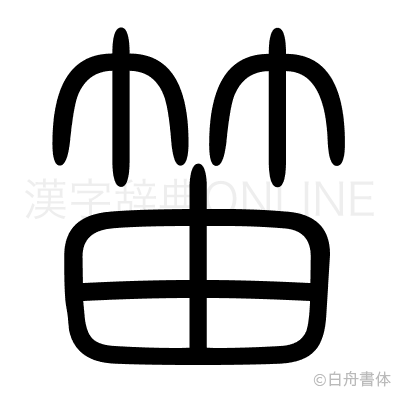
Blades of grass point up, and and leaves of bamboo dangle down. Neat!
228 notes
·
View notes
Text
i see it's that time of the year again where people start hating on the english localization of remake/rebirth despite having next to no understanding of how large scale translation projects work 🙃
#happens every few months or so and it's mildly aggravating every time#don't make me point at the sign that reads ''JPN/ENG TEAMS WORKED TOGETHER AND APPROVED EACH OTHER'S SCRIPTS'' again#sorry i'm just tired of the weird attitude some people get about the ~original japanese version~ being supposedly objectively superior#ff7s nowhere near the only series that suffers from this. i see it everywhere#and the amount of nitpicking is ridiculous. and it severely devalues the INCREDIBLE work that the english team has done.#localizations will never be 100% perfect. there's so much more to translate than just words. cultural context; intent; tone of voice etc#when restricted by extremely stringent lip syncing it's inevitable that some information will get lost or changed#and that's ok!! but people act like it's the end of the world when one (1) line has Ever So Slightly Different Implications#hhhHHHHHhhhhh.#hhhh.#i'm ok lol i just needed to complain a bit you know the drill
86 notes
·
View notes
Text
Quick over-analysis of the ways Barok and Albert address one another, because ace attorney loves showing personality through how characters refer to each other, and I love analyzing it.
Easy one out of the way, Albert exclusively refers to Barok as "Barok" regardless of the situation. He is the only character to do this, with every other character referring to him as some variation of "Prosecutor/Lord van Zieks". This establishes their friendship from the get-go, while also being a bit jarring to the audience as literally no one calls him just "Barok". Even characters who are closer to him, like Gregson and Stronghart, still call him "van Zieks". As far as Albert is concerned, that's just his good friend Barok, not the intimidating Prosecutor Lord van Zieks.
Barok meanwhile has two major ways of referring to Albert:
Firstly, "Albert". This one's simple, he's just reciprocating Albert's first name address, and further cementing their friendship. This is used almost exclusively outside of the courtroom, meanwhile within the courtroom he almost only uses "Professor Harebrayne". An exception to this is right after Albert is forced to accept that the experiment is a failure Barok says:
"And as for you… …Albert. You can't ignore this any longer."
It's a sudden departure from the distant, professional address he's been using the entire trial. It's also a much kinder approach than Barok usually takes when referring to defendants (or anyone really), something Susato comments on directly by saying she's "Never heard him speak that way before." He's breaking the Reaper Persona for just a moment to give his friend a firm, yet ultimately gentle, push.
Back to "Professor Harebrayne", while on the surface it seems distant there is one scene that shows an extra dimension. During the "Laudable not Laughable" scene, a sequence dedicated to Barok giving Albert what is essentially a pep-talk, you would expect him to return to the "Albert" address as seen earlier. Instead, he continues to use "Professor Harebrayne". My interpretation is that Barok is specifically calling attention to the fact that Albert is Professor Harebrayne. He has a title which he earned that is proof of his abilities as a scientist. Following that logic, "Professor Harebrayne" isn't just for formality's sake, but also a representation of the respect Barok holds for Albert separate from their status as friends.
However, Barok actually has a third way of referring to Albert that is used exactly once. In the line directly preceding Albert's (false) confession to murder, Barok says:
"What's all this about… Mr Harebrayne?"
Mr Harebrayne. Not Professor, not Albert, Mr.
If "Professor Harebrayne" is meant to show respect, and "Albert" is meant to show fondness, then clearly "Mr Harebrayne" is the absence of both.
He's not "Brilliant Scientist Professor Harebrayne" and he's not "Dear Friend Albert", he is Mr Harebrayne and he is about to do something so, so stupid. And there's nothing Barok can do to stop him.
My chosen interpretation is that this is Barok's desperate attempt to verbally smack some sense into Albert. This is like the Barok equivalent of grabbing Albert by the shoulders and yelling "What the hell do you think you're doing???"
As an aside, this comes right before the "...Albert. You can't ignore this any longer" line. Meaning the latter can almost been seen as an apology for being so harsh moments before.
Just, Mr Harebrayne. It's such a minor change, but I adore it so much. With how much care ace attorney puts into the way characters refer to each other, I have to assume it was intentional.
#ace attorney#tgaa#albert harebrayne#barok van zieks#for those curious I did check that what he says in the japanese script during the 'Mr Harebrayne' line#I can't read japanese but according to a direct translation by the poster he calls Albert 'Defendant'#which I think ultimately conveys the same thing:#Right before Albert confesses to murder Barok is suddenly significantly harsher on him#(Because his friend is about to something very dumb and Barok is having the worst time imaginable)#Now I might be projecting onto Barok with that one line about wanting to desperately shake Albert by the shoulders#because that's what I want to do during that scene#then again projecting onto Barok what I want to do to Albert is what I do everyday
98 notes
·
View notes
Text
some cool posts i found today!
y'all may be familiar with general macarthur's push to abolish kanji in written japanese during the US occupation after WW2, but tussles here and there about the role of kanji among japanese scholars and politicians have been ongoing since at least the meiji period:
44 notes
·
View notes
Text

Wakeman Labs' Robot Girl Safety Matches
Inspired by vintage Japanese matchbox labels.
#My Life as a Teenage Robot#mlaatr#Roz's art#eyestrain tw#this was supposed to be more inspired by a combination of historical Chinese art and Art Deco#but unfortunately it didn't work out so well#since Art Deco movement apparently wasn't big in China#I also wanted to use Chinese script#but I don't really know jack about Chinese language#plus I'm a little more familiar with Japanese
174 notes
·
View notes
Text
The writing in Metal Gear (1987) continues to crack me up. Diane finally stopped doing Generic Woman Activities™ (shopping, showering) and gives me advice when I call now (when she picks up, anyway) but she delivers it in the most condescending way possible. It's like:
Snake: Hello Diane this is Snake. I'm fighting a giant tank that wants to crush my guts out like a toothpaste tube. Please help
Diane: Uh. Yeah. Hello... Use some mines, I guess. Ok. Bye...
Everyone "helping" Snake on this mission HATES him, I'm totally convinced. This is a mission they wanted him to die on. There's no way they were expecting him to actually make it back alive
#textpost#I made it as far as the tank fight tonight but my controller inputs started drifting really bad and I kept dying#Idk if it's my controller itself (playing via bluetooth) or if it's the game engine throwing up but it was really annoying#So I stopped for the night#Need to look up the Japanese script for this game after I beat it lol#I need to know if this is a fault of the localization or if they really do just hate this poor bastard
22 notes
·
View notes
Text
I'm sure nobody cares, but i just have to share this experience rn. I have the jshk volumes in japanese and wanted to check the writing style of brush-chan. But i got distracted by the start of volume 10...and started listening to the newest episode.
It's such a cool experience to listen to their voices and reading the manga at the same time. What they're saying is written out almost absolutely the same...and this scene just got even more beautiful.

I'm so happy that I'm able to read along.
Mostly only the hiragana and katakana but shhhh. It's still very cool!!
#it felt like a reward for learning a bit japanese#tbhk#jshk#hananene#yukis thoughts#I didn't know until now how much they rely on the manga for their script
27 notes
·
View notes
Text
i saw people talking about hirano to kagiura ch 27 like WHERE are you people reading that, so i looked and found the raws
and I have no impulse control so I translated it
#i have. the full script.#idk anything about lettering but hey if anyone wants it#i should get someone to beta my japanese still isn't that good but woagh#compared to the other series i'm into hrkg is so easyyyyy bless you furigana#hirano to kagiura#PEOPLE ARE WRITING FICS ABOUT CH27 ALREADY ARE THESE JUST PEOPLE WHO CAN READ JAPANESE#also godddd hirano please. man please.
27 notes
·
View notes
Text

I... there's so much to say about this conversation with Espio from the Olympic 2012 London Party game.
Espio is so sheltered he doesn't know what a canoe is.
Only westerners use techniques such as "using a boat" to cross water.
He would rather walk on water than trust either Vector or Charmy to help paddle a canoe.
Espio is so sheltered he doesn't know a a canoe is and still has the nerve to insult your technique with one.
#espio the chameleon#sth#dialogue#informative espio post#mario & sonic olympic games#mario & sonic at the london 2012 olympic games#*blows the dust off my blog* hi#i quit cold turkey and stopped logging in sns completely cuz i started to doom scroll but i left for too long whoops#i'm a lurker at heart and regressed to my old ways#anyway#this feeds my personal “espio grew up sheltered” headcanon#ive been ripping the text out of the olympic games lately and i fucking love it#so much weird obscure niche shit#it's what i live for#i have the JP script too and need to find the file that has this text but japanese#oh yeah and bullet point 5:#i love him#<3<3<3<3<3
22 notes
·
View notes
Text
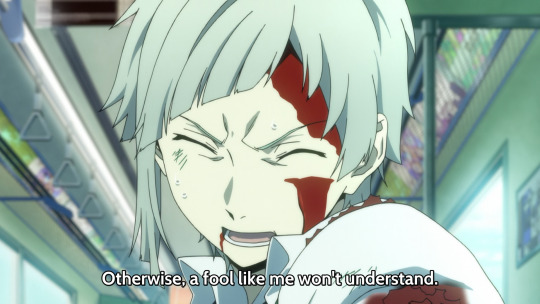
So, it's Atsushi who calls himself a “fool” the first time? And since we know for sure (chapter 35) that Akutagawa was listening in to what was happening... It's compelling to think Akutagawa might actually have been quoting Atsushi himself this whole time, every time he called him “fool”.
I actually think it would be really fitting for Akutagawa. Because Akutagawa stretches a lot on how pathetic it is of Atsushi to always be dwelling on his past sufferings (“Let me tell you why I said you disgust me. [...] You're an imbecile who keeps dwelling on old wounds!”, chapter 35), and loathes him for being so self-deprecating. Then, for Akutagawa to call him fool, but that being a word Atsushi for the first time used to define himself, it would be like Akutagawa was telling him: “you're a fool because you himself call yourself that. You're a fool because that's what you decide to be.”
#I checked the chapter 8 raws and it seems like this was an anime addition.#Give me ten seconds and I'll check the Japanese script to see if the word Atsushi is using here is indeed 愚#atsushi nakajima#ryūnosuke akutagawa#sskk#shin soukoku#bsd#bungou stray dogs#bsd s1#bsdrewatch2023
182 notes
·
View notes
Text
Does anyone have the appetite for yet more Chinese restaurant calligraphy? Because we've covered the seal script version of one character for chicken 鳥, but now I've got 鶏 too!

How about that? The name of this restaurant is 鶏門, literally Chicken Gate, (probably) read Keimon.
鶏 means chicken. The right radical, 鳥, means chicken or bird. It's read にわとり (when referring to a live chicken), とり, or ケイ.
門 means gate (and doesn't it look like one?). It's also used as the counter for cannons. It's read かど, と, or モン.
The text above the seal script says 本格四川料理 [ほんかく・しせん・りょうり], or Authentic Szechuan Cuisine.
The text at the bottom says 当店名物よだれ鶏 【とうてん・めいぶつ・よだれどり】, or House Specialty: Yodare-Dori. I've written about this dish on my food blog before, but the name means "drool chicken," because it's so mouthwateringly tasty. Its Chinese name is actually 口水鸡 kǒushuǐjī, literally "mouth water chicken."
27 notes
·
View notes